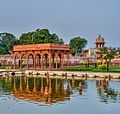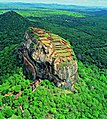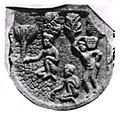Portal:Gardening
The Gardening Portal

Gardening is the process of growing plants for their vegetables, fruits, flowers, herbs, and appearances within a designated space. Gardens fulfill a wide assortment of purposes, notably the production of aesthetically pleasing areas, medicines, cosmetics, dyes, foods, poisons, wildlife habitats, and saleable goods (see market gardening). People often partake in gardening for its therapeutic, health, educational, cultural, philosophical, environmental, and religious benefits. Gardening varies in scale from the 800 hectare Versailles gardens down to container gardens grown inside. Gardens take many forms, some only contain one type of plant while others involve a complex assortment of plants with no particular order. (Full article...)
Horticulture is the science, technology, art, and business of cultivating and using plants to improve human life. Horticulturists and Horticultural Scientists create global solutions for safe, sustainable, nutritious food and healthy, restorative, and beautiful environments. This definition is seen in its etymology, which is derived from the Latin words hortus, which means "garden" and cultura which means "to cultivate". There are various divisions of horticulture because plants are grown for a variety of purposes. These divisions include, but are not limited to: gardening, plant production/propagation, arboriculture, landscaping, floriculture and turf maintenance. For each of these, there are various professions, aspects, tools used and associated challenges; Each requiring highly specialized skills and knowledge of the horticulturist. (Full article...)
General images -
Selected article -

Urban agriculture refers to various practices of cultivating, processing, and distributing food in urban areas. The term also applies to the area activities of animal husbandry, aquaculture, beekeeping, and horticulture in an urban context. Urban agriculture is distinguished from peri-urban agriculture, which takes place in rural areas at the edge of suburbs.
Urban agriculture can appear at varying levels of economic and social development. It can involve a movement of organic growers, "foodies" and "locavores", who seek to form social networks founded on a shared ethos of nature and community holism. These networks can develop by way of formal institutional support, becoming integrated into local town planning as a "transition town" movement for sustainable urban development. For others, food security, nutrition, and income generation are key motivations for the practice. In either case, the more direct access to fresh vegetable, fruit, and meat products that may be realised through urban agriculture can improve food security and food safety while decreasing food miles, leading to lower greenhouse gas emissions, thereby contributing to climate change mitigation. (Full article...)Selected image

Related portals
Did you know -
- ... that the runway at the Winter Garden Theatre was nicknamed the "bridge of thighs" after lightly clothed showgirls paraded down it?
- ... that American root doctor Valerie Boles was the inspiration for the character Minerva in the book Midnight in the Garden of Good and Evil and its film adaptation?
- ... that popular garden plants like malfurada often escape from cultivation and become invasive?
- ... that Monmouth Coffee Company in Covent Garden was one of the foundations for the third wave of coffee in London?
- ... that the firm of Israel Sack supplied American antiques to leading private collectors and museums, including the Winterthur Museum, The Henry Ford, and the Metropolitan Museum of Art?
- ... that Xu Garden was created by community residents grateful to their local warlord?
- ... that a "bat ensnared by a plant" was discovered in the garden of the Palestine Museum of Natural History?
- ... that Ardwall House has a garden ornament in the form of an early mediaeval Pictish slab inscribed with a Celtic cross?
Things you can do
- This list is transcluded from the tasks list page. To edit the list, click here
 |
Here are some tasks awaiting attention:
|
WikiProjects
Topics
Categories
Associated Wikimedia
The following Wikimedia Foundation sister projects provide more on this subject:
-
Commons
Free media repository -
Wikibooks
Free textbooks and manuals -
Wikidata
Free knowledge base -
Wikinews
Free-content news -
Wikiquote
Collection of quotations -
Wikisource
Free-content library -
Wikiversity
Free learning tools -
Wiktionary
Dictionary and thesaurus






















































































